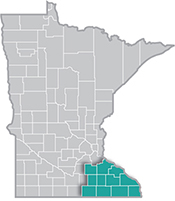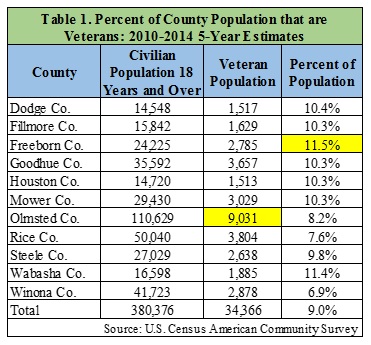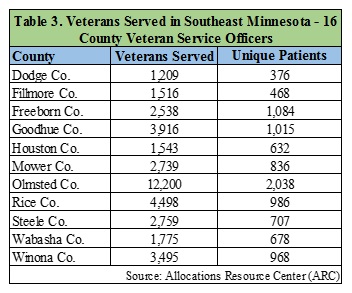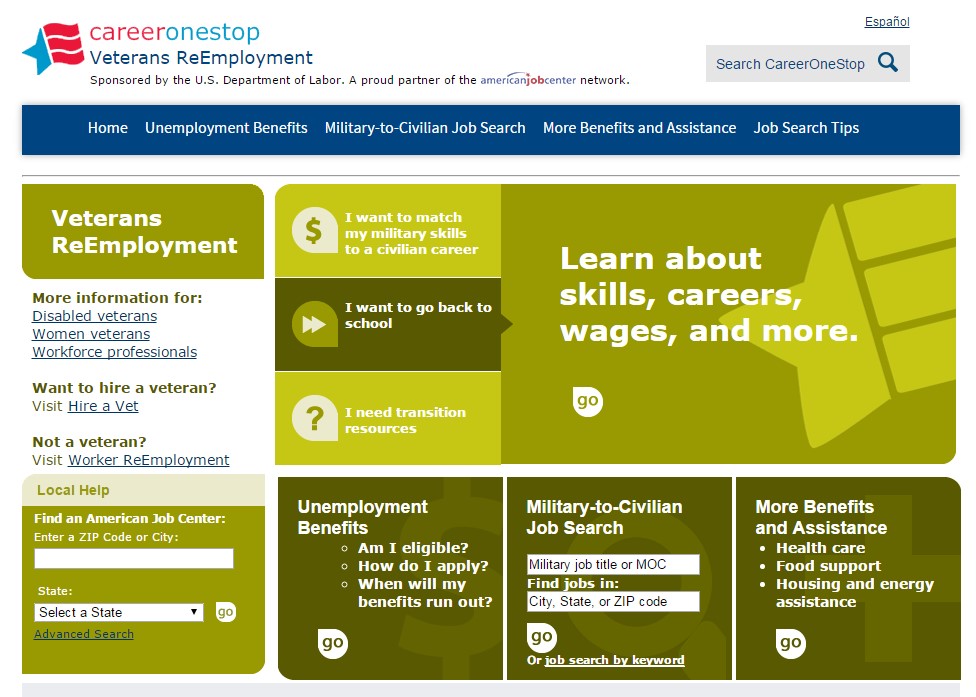 Southeast Minnesota is a health care and agricultural powerhouse. The region is home to the renowned Mayo Clinic and some of the world's most recognized food companies and brands.
Southeast Minnesota is a health care and agricultural powerhouse. The region is home to the renowned Mayo Clinic and some of the world's most recognized food companies and brands.
Advanced manufacturing is especially strong here, with machinery, chemicals, and electronics among the top products.
Want the freshest data delivered by email? Subscribe to our regional newsletters.
11/7/2016 9:47:04 AM
Over 34,000 veterans live in Southeast Minnesota (Table 1), with Olmsted County being home to the highest number and Freeborn County having the highest share of residents who are vets. Unfortunately, many of them come back from active duty and struggle to obtain and retain work.

To help them succeed in the labor force, DEED employs Local Veterans Employment Representatives (LVERs) and Disabled Veteran Outreach Program specialists (DVOPs). These professionals provide assistance to veterans in general and those with service-connected disabilities. Detailed descriptions of their tasks appear below.
|
Local Veterans Employment Representatives |
Disabled Veteran Outreach Specialists |
|---|---|
|
Supervise the provision of all services to Veterans furnished by employment service employees, including counseling, testing, and identifying training and employment opportunities Monitor job listings from Federal contractors to see that eligible Veterans get priority in referrals to these jobs Monitor Federal department and agency vacancies listed at local state employment service offices and preliminary processing of complaints from Veterans about the observance of Veterans' preference by Federal employers Promote and monitor the participation of Veterans in Federally-funded employment and training programs Cooperate with the Department of Veterans Affairs to identify and aid Veterans who need work-specific prosthetic devices, sensory aids or other special equipment to improve their employability; and contacting community leaders, employers, unions, training programs and Veterans' Service Organizations to be sure eligible Veterans get the services to which they are entitled |
Develop job and training opportunities for Veterans, with special emphasis on Veterans with service-connected disabilities Provide direct services to Veterans enabling them to be competitive in the labor market Provide outreach and offer assistance to disabled and other Veterans by promoting community and employer support for employment and training opportunities, including apprenticeship and on-the-job training Work with employers, Veterans' organizations, the Department of Veterans Affairs, Department of Defense, and community-based organizations to link Veterans with appropriate jobs and training opportunities Serve as case managers for Veterans enrolled in Federally-funded job training programs such as the Department of Veterans Affairs' Vocational
Help disabled Veterans and their employers to help ensure that necessary follow up services are provided to promote job retention |
|
Source: U.S. Department of Veterans Affairs |
|
DEED’s LVERs and DVOPs are an incredibly valuable asset to veterans, since many have difficulties finding and retaining work. Scott Metcalf, Disabled Veteran Outreach Specialist in Southeast Minnesota, says that one issue veterans face is that many employers require college credits or certificates. However, some employers will not accept military training as a substitute.
Jerry Obieglo, a Winona County Veterans Service Officer, agrees that military certifications do not transfer over. However, Obieglo says this can be overcome. There are tests and state licensing procedures that can be completed, although some veterans may become discouraged by the process. Obieglo adds that those returning from combat areas may need more adjustment time.
Metcalf has been a busy guy in helping veterans in the region over the past year. He has assisted over 270 Veterans, 73 of whom had a service-related disability (Table 2). What is unsettling is the number of veterans without a home. Just over six percent of those who Metcalf has assisted are homeless, which exacerbates the struggles that these veterans are already experiencing.

County Veteran Service Officers have also been a critical and effective resource for veterans (Table 3). Currently, the County Veterans Service Officers are serving over 38,000 veterans throughout the 11 counties in the region, with Olmsted County having the most veterans who sought county services.
These numbers are similar to but don’t match the numbers in Table 1. In Table 3, veterans may be counted multiple times if they served multiple deployments – they are counted each time they return and submit their 214 discharge papers. If one person served three deployments and submitted their 214 each time, they would be counted three times.

Furthermore, if a veteran passes away, they remain active in the county records as being served until their spouse also passes away. Additionally, just over one-quarter of those who received assistance from County Veteran Service Officers were unique patients – those who received treatment at a Veterans Affairs health care facility.
Another form of assistance for veterans is CareerOneStop, where veterans can find information on skills, careers, wages, and more. As seen in the screenshot, there is a wealth of information for veterans to help them gain and retain employment. There is information on matching military skills to civilian careers, education options, transition resources, unemployment benefits, health care, food support, housing and energy assistance, as well as many other topics. This information is also available for specific veteran types, such as those with a disability and women veterans.

It is unfortunate that veterans often face struggles when searching for work, but luckily there are excellent resources available through DEED, County Veterans Services Offices, and online sources such as CareerOneStop to help them find and retain employment; all working to serve those who have served us.
Contact Mark Schultz.